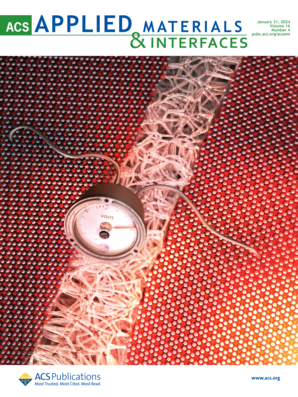Sensing of Organic Vapors with Plasmonic Distributed Bragg Reflectors
IF 8.3
2区 材料科学
Q1 MATERIALS SCIENCE, MULTIDISCIPLINARY
引用次数: 0
Abstract
In recent years, advancements in air quality monitoring have been driven by the development of various sensor technologies, each with distinct advantages and limitations. Among these, polymer-based Distributed Bragg Reflectors (DBRs) have garnered significant interest for use in cost-effective, portable colorimetric sensors for detecting volatile organic compounds (VOCs). However, a key challenge in the fabrication of polymer-based DBRs lies in achieving an adequate refractive index contrast between the individual polymer layers. In this work, we fabricate plasmonic DBR sensors by a combination of low-temperature plasma-based techniques with reduced environmental footprint, investigate their potential as VOC sensors, and propose an optical model that links the sensors’ optical properties and microstructure. Plasmonic nanoparticles of silver (Ag) are synthesized by gas aggregation and embedded into thermally evaporated poly(lactic acid) (PLA) layers to create nanocomposites with an enhanced refractive index (∼2.0). A 6-bilayer plasmonic DBR sensor is then produced by alternating depositions of plain PLA and nanocomposite layers as low and high refractive index materials, respectively. The resulting DBR achieves a 77% reflectance at 570 nm. The potential use-case of such a DBR as a VOC sensor is highlighted by its optical response upon exposure to ethanol (a model VOC) vapors as well as other VOCs (water, propanol, acetone, hexane). In an ethanol atmosphere, swelling of the polymer layers occurs, resulting in a red-shift of the reflection peak to 640 nm and a change in the DBR color. We take advantage of a generalized Maxwell-Garnett approach to create an advanced model that accurately reproduces the DBR spectra and captures swelling and degradation by accounting for structural changes and the behavior of isolated and coalesced Ag NPs within individual layers. Despite a decrease in the sensing performance with the number of swelling cycles, these plasmonic DBRs offer a promising solution for low-cost real-time VOC sensing.

等离子体分布布拉格反射器对有机蒸汽的传感
近年来,各种传感器技术的发展推动了空气质量监测的进步,每种传感器技术都有其独特的优势和局限性。其中,基于聚合物的分布式布拉格反射器(DBRs)在用于检测挥发性有机化合物(VOCs)的成本效益高的便携式比色传感器中获得了极大的兴趣。然而,在聚合物基dbr的制造中,一个关键的挑战在于在各个聚合物层之间实现足够的折射率对比。在这项工作中,我们通过结合低温等离子体技术和减少环境足迹来制造等离子体DBR传感器,研究它们作为VOC传感器的潜力,并提出了一个将传感器的光学特性和微观结构联系起来的光学模型。银等离子体纳米粒子(Ag)通过气体聚集合成,并嵌入热蒸发聚乳酸(PLA)层中,以创建具有增强折射率(~ 2.0)的纳米复合材料。然后,通过将普通PLA层和纳米复合层分别作为低折射率和高折射率材料交替沉积,制备了6层等离子体DBR传感器。所得DBR在570nm处达到77%的反射率。DBR作为挥发性有机化合物传感器的潜在用途是,它在暴露于乙醇(一种模型挥发性有机化合物)蒸汽以及其他挥发性有机化合物(水、丙醇、丙酮、己烷)时的光学响应。在乙醇气氛中,聚合物层发生膨胀,导致反射峰红移至640 nm, DBR颜色发生变化。我们利用广义麦克斯韦-加内特方法创建了一个先进的模型,该模型准确地再现了DBR光谱,并通过计算结构变化和单个层内孤立和聚结银纳米粒子的行为来捕获膨胀和降解。尽管随着膨胀循环次数的增加,传感性能会下降,但这些等离子体dbr为低成本的实时VOC传感提供了一个有前途的解决方案。
本文章由计算机程序翻译,如有差异,请以英文原文为准。
求助全文
约1分钟内获得全文
求助全文
来源期刊

ACS Applied Materials & Interfaces
工程技术-材料科学:综合
CiteScore
16.00
自引率
6.30%
发文量
4978
审稿时长
1.8 months
期刊介绍:
ACS Applied Materials & Interfaces is a leading interdisciplinary journal that brings together chemists, engineers, physicists, and biologists to explore the development and utilization of newly-discovered materials and interfacial processes for specific applications. Our journal has experienced remarkable growth since its establishment in 2009, both in terms of the number of articles published and the impact of the research showcased. We are proud to foster a truly global community, with the majority of published articles originating from outside the United States, reflecting the rapid growth of applied research worldwide.
 求助内容:
求助内容: 应助结果提醒方式:
应助结果提醒方式:


